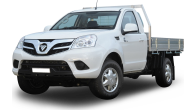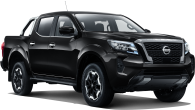LDV, a division of China’s largest automotive manufacturer SAIC Motor, has been selling its T60 ute in Australia since 2017, during which time it’s established a solid foothold in the low-priced ute segment against similar rivals from China (GWM) and Korea (Ssangyong).
During that time LDV has released numerous T60 variants, including the limited edition Trailrider in 2019 with value-added features and unique Walkinshaw suspension tuning optimised for Australian conditions.
The T60 Mega Tub was released the same year, with a big 315mm increase in wheelbase and 275mm stretch in load tub length. The T60 Trailrider 2 followed in 2020, showcasing SAIC’s first in-house designed 2.0-litre four-cylinder turbo-diesel (engine code D20) setting new LDV performance benchmarks of 120kW/375Nm.
LDV has continued that evolution with its latest version called the T60 Max with a striking facelift, on-demand 4x4 and more powerful bi-turbo version of the D20, offering four-cylinder class-leading outputs of 160kW/500Nm.
According to LDV, it now has the performance credentials to more than match HiLux and Ranger in Australia’s 4x4 ute market and at a much lower price. We recently tested one to find out if it’s on the money.
LDV T60 2022: Max Luxe (4X4)
| Engine Type | Twin Turbo 4, 2.0L |
|---|---|
| Fuel Type | Diesel |
| Fuel Efficiency | 9.3L/100km (combined) |
| Seating | 5 |
| Price From | $23,980 - $29,590 |
| Safety Rating |
|
Price and Features – Does it represent good value for the price? What features does it come with?
The T60 Max, like its predecessors, is available in a choice of Pro and Luxe suspension tunes, with Pro being the more work-focused option with the highest payload rating.
Our Lava Grey test vehicle is the softer-riding and premium-priced Luxe version, which with LDV’s latest 2.0-litre four-cylinder bi-turbo diesel comes standard with a six-speed manual, or optional eight-speed ZF automatic transmission like our example for a list price of $42,621. This compares favourably with Chinese rival GWM and its premium Cannon X at $45,490 and Ssangyong’s top-shelf Musso Ultimate XLV at $44,150.
The T60 Max Luxe comes standard with 17-inch alloys and Giti 245/65R17 tyres with a full-size steel spare. There’s also keyless entry and start, leather-accented seat trim with six-way power-adjustable and heated front seats, adjustable a/c vents in the centre console for rear seat passengers, spray-in tub-liner, LED headlights/DRLs, automatic rear diff-lock, rear parking sensors, reversing camera, 360-degree camera and tyre pressure monitoring.
.jpg)
Connectivity includes two USB ports and a 12-volt accessory plug, plus there’s a six-speaker infotainment system with landscape-style 10.25-inch touchscreen and Apple CarPlay/Android Auto. However, you don’t get other desirables like side-steps, sports bar, tonneau cover or tow-bar. And its five-star ANCAP rating, achieved in 2017, does not include AEB and other important active features.
Design – is there anything interesting about its design?
If you want a ute with visual impact, this jigger hits like a hammer. The massive grille is imposing and very distinctive, which combined with the new headlight design leaves no one in any doubt that it’s a T60 Max.
There’s no risk of mistaken identity from the rear either, with ‘T60 MAX’ boldly displayed across the tailgate. However, those big letters and numbers are embossed in a plastic moulding that’s attached to the outer skin of the tailgate, which (to us at least) looks like a cheap afterthought that detracts from the vehicle’s appearance.
.jpg)
The T60 Max is smaller in all key dimensions than a Ford Ranger XLT dual-cab ute. Its 3155mm wheelbase is 65mm shorter, its 5365mm length is 81mm shorter, its 1900mm width (mirrors folded) is 77mm narrower, its 1809mm height is 12mm lower and its 12.6-metre turning circle is a fraction tighter. The T60 uses a conventional body-on-frame design with twin-wishbone front suspension, leaf-spring live rear axle, hydraulic power-assisted rack and pinion steering and four-wheel disc brakes.
The overall build quality and standard of finish is acceptable for a vehicle in this price range, with the interior displaying nice detailing like contrasting red stitching and a tasteful mix of satin chrome, piano black and satin black highlights.
.jpg)
However, the front seats feel like you’re sitting on them more than in them, as they are quite firm and flat without much lateral support. The driver’s base cushion, even at its lowest setting, is also quite high relative to the dashboard height. However, this can also be an advantage particularly when driving off-road, as it provides a better view over the bonnet.
Rear seating is surprisingly comfortable, even for tall passengers. With the driver’s seat in my position (I’m 188cm) I still had about 80mm of clearance between my knees and the driver’s seat backrest while sitting in the rear seat, which is unusually spacious for a dual-cab ute. There’s also ample headroom, but shoulder room for three is tight like all dual cabs of this size.
.jpg)
Engine and transmission – What are the key stats for the engine and transmission?
The T60’s new powertrain features SAIC’s first in-house designed bi-turbo diesel engine, based on the single-turbo D20 unit introduced with the previous model. It’s a Euro 5-compliant 2.0-litre four-cylinder producing an unprecedented 160kW at 4000rpm and 500Nm between 1500-2400rpm. Significantly, those muscular numbers are superior to both Toyota’s 150kW/500Nm 2.8-litre HiLux and Ford’s 157kW/500Nm 2.0-litre bi-turbo Ranger.
The ZF-designed eight-speed torque converter automatic, with a choice of Eco or Power modes, is a smooth-shifting and intelligent transmission that learns driver characteristics and adjusts shift protocols to optimise performance.
.jpg)
It’s mated to a Borg Warner ‘Torque on Demand’ 4x4 transmission that automatically monitors grip levels and delivers all-wheel drive traction as required. The driver can override this with manual selection of either 4x2 high-range, 4x4 high-range and 4x4 low-range, but the rear diff-lock operates automatically (under 30km/h) and can’t be engaged or disengaged by the driver.
Fuel consumption – How much fuel does it consume?
LDV claims an official combined figure of 9.3L/100km which was close to the dash readout’s 9.8 at the end of our 365km test, of which about one third was under near-maximum payload. That was commendably close to our own 10.1 calculated from fuel bowser and tripmeter readings. Therefore, based on our figures, you could expect a real-world driving range of around 700km from its 73-litre tank.
Practicality – How practical is the space inside?
Our Luxe auto’s 2150kg kerb weight and 2900kg GVM results in a 750kg payload rating, which is 185kg less than the more work-focused Pro’s 935kg limit. It’s also rated to tow up to 3000kg of braked trailer.
However, we can’t tell you the T60’s Gross Combination Mass (that's how much it can legally carry and tow at the same time) as GCM ratings remain a closely-guarded secret at LDV. We continue to be baffled why such important figures are not published, because it’s literally anyone’s guess how much payload you can legally carry when towing 3000kg.
The cargo tub, when measured at the top, is almost square with dimensions of 1525mm in length and 1510mm in width, with a depth of 530mm and 1131mm between the wheel housings. It’s protected by a spray-in tub-liner and has four load-anchorage points. There’s also a decent-sized step in the centre of the rear bumper for accessing your load with the tailgate closed.
.jpg)
Cabin storage includes a large-bottle holder and bin in the base of each front door, plus a closable dashboard compartment near the driver’s right leg for small items. There’s also a shallow storage tray set into the central dash-pad, an overhead glasses holder and a single glovebox. The centre console has open storage up front, two small-bottle/cup holders in the centre and a lidded box at the back.
Rear passengers get a large-bottle holder and bin in each door plus flexible pouches on each front seat backrest. And there’s a pull-down centre armrest with dual small-bottle/cup-holders.
.jpg)
The rear seat base can swing up through 90 degrees and be stored vertically when more internal load space is required. This also provides access to a pair of under-floor storage compartments. However, one is largely filled with wheel-changing equipment while the other houses electrical components, so their value as extra storage space is limited.
What’s it like as a daily driver?
There are large handles on the passenger side A pillar and both B pillars to assist passengers when climbing aboard, which is handy given there are no side-steps.
The bi-turbo engine has ample performance, if a little slow on the uptake below 2000rpm when accelerating hard from standing starts. There’s good pulling power under load and the eight-speed automatic works well in keeping the engine operating within its 1500-2400rpm peak torque zone in most city and suburban driving. It’s quiet and comfortable at highway speeds, requiring only 1800rpm to maintain 100km/h and 2000rpm at 110km/h, which is also bang in the middle of its peak torque zone.
.jpg)
The power-assisted steering has a rather heavy and lifeless feel, with weighting that feels the same at parking speeds as it does at highway speeds. The brake pedal effort is also a tad higher than we’re used to, which could be caused by either inadequate power assistance or overly-hard pad compounds or a combination of both. Either way, steering and braking would benefit from further refinement.
The unladen ride quality is reasonably compliant, as you’d expect given its lower payload rating. However, the driver’s base cushion is too short for proper under-thigh support (for tall drivers at least) and can feel like you’re sliding off the front of it at times. Fortunately, there’s a large and well-placed left footrest to largely counter this.
What’s it like for tradie use?
We forklifted 565kg into the load tub, which with a crew of two equalled a 714kg payload that was less than 40kg under the maximum 750kg rating. The rear leaf springs compressed 60mm, which only left about 25mm of static bump-stop clearance. As a result, we were expecting lots of bottoming-out but were pleasantly surprised to only feel thuds over the largest of bumps.
It proved to be a competent load-hauler, particularly on our 13 per cent gradient, 2.0km-long set climb at 60km/h. In automatic mode, it promptly shifted down to fifth and with only 2000rpm on the tacho and lots of accelerator travel remaining, cleared the climb with consummate ease.
.jpg)
Engine-braking on the way down, in a manually-selected second gear, was outstanding for an engine of this size. It never exceeded 3500rpm on overrun (soft redline starts at 3750rpm) and maintained a road speed of only 40km/h without once needing a prod of the middle pedal. Even allowing for its modest payload limit, that’s the strongest engine-braking performance we’ve seen not only from a 2.0-litre turbo-diesel but larger displacement versions as well.
Warranty & Safety Rating
Safety – What safety equipment is fitted? What safety rating?
T60 comes with a five-star ANCAP rating, albeit achieved in 2017, so there’s no AEB, forward collision warning, rear cross-traffic alert or blind-spot monitoring. However, you do get six airbags including full-length side curtains, rear parking sensors, tyre pressure monitoring, reversing/360-degree cameras, lane departure warning and more. There’s also ISOFIX and top-tether child seat anchoring for the outer rear seating positions.
Ownership – What does it cost to own? What warranty is offered?
The T60 is covered by LDV's five year/130,000km warranty plus five year/130,000km roadside assist. Scheduled servicing every 15,000km/12 months whichever occurs first. No capped-price servicing.
Verdict
Chinese ute manufacturers, although improving, still have a way to go in matching the overall refinement of the leading players in this segment. That said, the T60 Max with its bold styling, powerful engine, solid warranty and low pricing is certainly worthy of consideration and a decent test drive by ute bargain hunters.
Pricing Guides








.jpg)
.jpg)
.jpg)
.jpg)
.jpg)










.jpg)
.jpg)